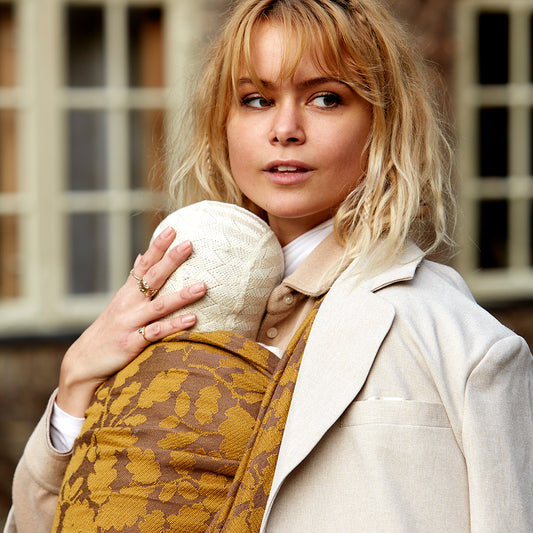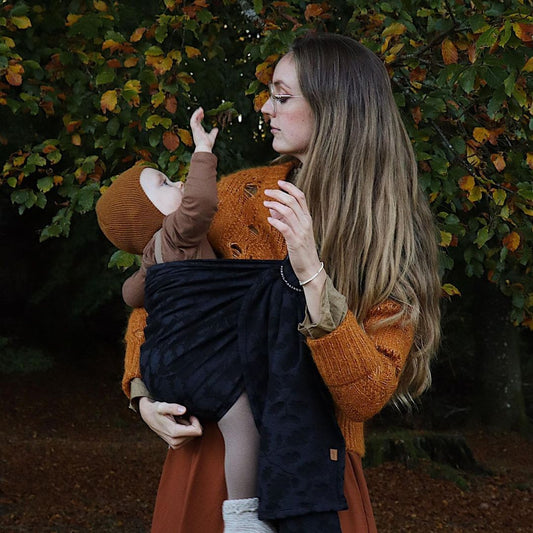In this article, I will explain the difference between these two types of carriers and help you decide whether a ring sling or a woven wrap is the right choice for you and your child.
PHYSICAL DIFFERENCES
At first glance, a ring sling and a woven wrap might seem quite similar: both are long pieces of fabric used to carry a child. However, they are used quite differently. The key difference in construction is that while a woven wrap is simply a long piece of fabric (often over 4 meters long), a ring sling is typically much shorter (about 2 meters). Additionally, a ring sling has two large rings sewn onto one end.
In a ring sling, one end is threaded through the rings, securing it in place and creating a fabric pocket that can be easily adjusted. The sling is worn over one shoulder, and the child is secured by tightening the fabric through the rings.
With a woven wrap, the fabric is wrapped around both the child's and the wearer's bodies and secured with a double knot using the wrap's ends.
COMFORT
Weight Distribution
Both carriers are ergonomically correct for the child, so the comfort difference between a sling and a woven wrap is mainly felt by the person carrying. A ring sling distributes the child's weight over one shoulder and your back. A woven wrap can be tied to distribute the child's weight over both shoulders, back, and hip. In short, a woven wrap symmetrically distributes the child's weight over a larger area.
Temperature
A ring sling consists of a single layer of fabric around the child and the adult, while a woven wrap can have multiple layers, depending on how it's tied. This provides additional support but also warmth. A ring sling might be a good choice if you or your child tend to get very warm and sweaty since there's less fabric enveloping you. However, there are many ways to tie a woven wrap that can result in only one layer of fabric around you and your child.
Speed
Woven wraps can be pre-tied for quick use, but in my opinion, the ring sling is unbeatable in terms of speed. If you need a carrier for quick ups and downs, it takes only a moment to get the child in the sling once you've mastered the technique. Taking the child out is even faster – just lift the bottom ring, and the ring sling quickly and easily loosens so you can put your child down.
VERSATILITY
A woven wrap in your base size can be used to carry your child on the front, hip, or back. Ring slings are mostly used for front carries or, as the child grows and becomes more curious, on the hip. Although it's technically possible to carry on the back using a ring sling, I find that the wearer's comfort is limited. If you intend to use your carrier for back carries, I recommend choosing a woven wrap as it offers more options for comfortably carrying your child on your back for extended periods.
PRACTICALITY
Transporting the Carrier
The ring sling is short and takes up very little space in a diaper bag. Many people, including myself, find merino slings excellent as soft and warm scarves. This use also ensures that I'm never without a sling when my children get tired of walking or just need to be held. Both the ring sling and the woven wrap are excellent as backup blankets, scarves, or sunshades.
Breastfeeding
It's possible to breastfeed while using either a sling or a woven wrap. It's quicker in a ring sling, but it's not overly complicated in a woven wrap tied in, for example, a Front Wrap Cross Carry.
Freedom of Movement
Having hands-free while holding your child is one of the biggest advantages of babywearing. With a ring sling, your carrying arm/shoulder is somewhat restricted, depending on how much fabric you spread over the shoulder. On the other hand, your other arm is completely unrestricted. With a woven wrap, your freedom of movement depends on how you tie the wrap. For example, a standard FWCC tie provides very good freedom of movement for both arms.
CHILD'S AGE
Newborn (0-2 months)
From my own experience, I've used both ring slings and woven wraps a lot when my babies were newborns. When babies are small and light, it's not particularly strenuous to carry them with the weight on one shoulder using a ring sling. The lesser amount of fabric in a ring sling can be advantageous if your child is born in the warmer months of the year. A woven wrap is excellent for swaddling and a great rescue for late nights. It also provides good symmetrical support for your body as it recovers after childbirth.
Baby (2-12 months)
As my babies grew a bit older, a woven wrap was my best tool for getting them to sleep and for transporting them while tending to older children, being out and about, cooking, etc. The ring sling was invaluable for shorter errands like dropping off the eldest at daycare and other daily tasks.
Toddler (1 year+)
When my children could walk, the sling experienced a renaissance – as "strong independent babies," they didn't let me carry them in the wrap for long periods often, but the sling was incredibly handy to have on hand instead of a stroller. The woven wrap is still magical for calming night owls, sick children needing comfort, and for long walks where I can carry the child on my back.
Is it difficult to learn?
It takes a bit of practice, but it's not hard to learn to use a sling or a woven wrap. There are plenty of online resources, video guides, and wonderful communities of dedicated baby-wearing mothers and fathers who are more than happy to help you get your carrier adjusted perfectly. There are even certified babywearing consultants who offer one-on-one help in your own home.
CONCLUSION
Ring slings and woven wraps are both ergonomic baby carriers that are very comfortable and allow you, as a parent, to carry your child while keeping your hands free. Depending on the types of situations you intend to use your carrier in, either a ring sling or a woven wrap might be right for you.
Ring slings and woven wraps complement each other, and it's quite common to own both a woven wrap and then supplement with a ring sling for quicker "ups and downs."
Please note that this article is based on typical use and is intended as a guide for those choosing their first baby carrier. Some people prefer ring slings for all carrying needs, and vice versa. There's no "wrong way" to carry your child, as long as the child is securely positioned with an open airway and it's comfortable for both of you.
I hope this guide helps you decide which carrier is right for you. If you need further guidance, I'm here to help. ♡
Warm regards,
Christine










